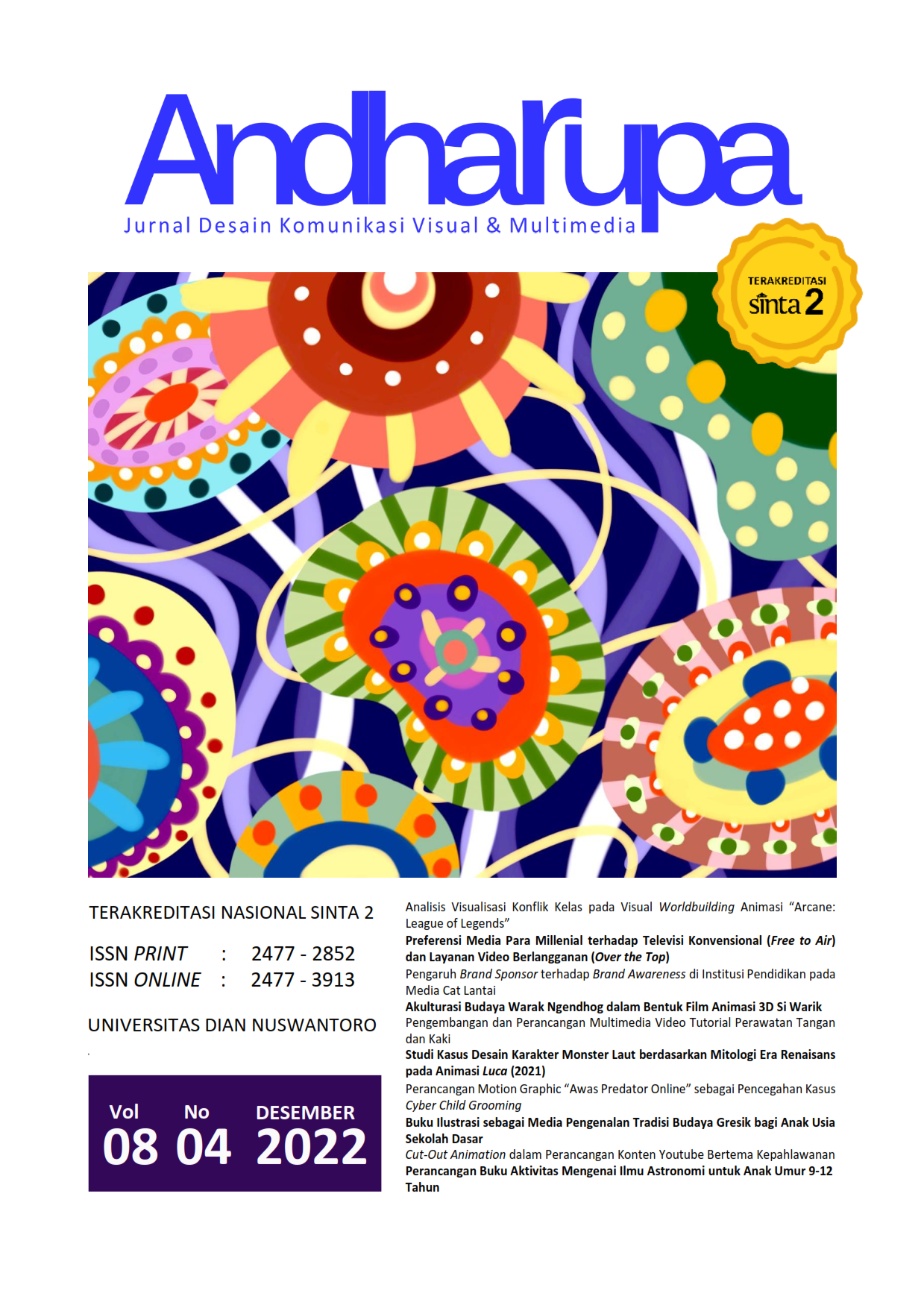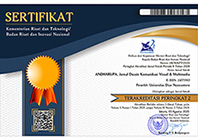Cut-Out Animation dalam Perancangan Konten Youtube Bertema Kepahlawanan
DOI:
https://doi.org/10.33633/andharupa.v8i04.7632Abstract
AbstrakYoutube merupakan media yang baik untuk membantu anak-anak belajar tentang sejarah. Namun konten sejarah di kanal Youtube dalam bentuk masih belum banyak ditemui salah satunya karena proses pembuatan konten animasi yang cenderung sulit. Cut-out animation merupakan teknik animasi yang sederhana dalam proses produksinya sehingga penelitian ini bertujuan untuk merancang sebuah film animasi infografis dengan konten sejarah dengan pemilihan kisah Pahlawan Indonesia yaitu pangeran Diponegoro dengan menggunakan teknik cut-out animation untuk konten Youtube. Metode penelitian yang digunakan adalah MDLC (Multimedia Development Life Cycle) meliputi Concept (Topic, Data Search, Analysis, Synopsis, Script), Design (Asset Design, Storyboard), Material Collecting (Dubbing), Assembly (Animate, Input Audio, Editing), Testing (Rendering, Testing), dan Distribution (Publishing). Penelitian ini menghasilkan film animasi sejarah berjudul Diponegoro berdasarkan kisah Pangeran Diponegoro yang dibuat dengan teknik cut-out animation. Teknik cut-out animation sangat cocok untuk konten Youtube khususnya yang bertema kepahlawanan karena proses produksinya sederhana dan hasilnya menarik, singkat, lengkap, sederhana, membantu daya ingat informasi, serta mendorong penonton untuk berlangganan (subscribe). Kata Kunci: Animasi Sejarah, Cut-out animation, MDLC, Youtube AbstractYoutube is an excellent medium to help children learn about history. However, historical content on the Youtube channel in the form still needs to be widely found because the process of creating animated content tends to be complicated. Cut-out animation is a simple animation technique in the production process. This research aims to design an infographic animated film with historical content by choosing the story of an Indonesian hero, Prince Diponegoro, using cut-out animation techniques for YouTube content. The research method used is MDLC (Multimedia Development Life Cycle) covering Concept (Topic, Data Search, Analysis, Synopsis, Script), Design (Asset Design, Storyboard), Material Collecting (Dubbing), Assembly (Animate, Audio Input, Editing), Testing (Rendering, Testing), and Distribution (Publishing). This research produced a historical animated film entitled Diponegoro based on Prince Diponegoro's story, which was made using cut-out animation techniques. The cut-out animation technique is very suitable for Youtube content, especially those with heroic themes because the production process is simple. The results are interesting, short, complete, and simple, which helps information retention and encourages viewers to subscribe. Keyword: Cut-out animation, Historical Animation, MDLC, YoutubeReferences
Amali, L. N., Zees, N., & Suhada, S. (2020). Motion graphic animation video as alternative learning media. Jambura Journal of Informatics, 2(1), 23-30.
Anam, K. (2022) Instagram & Tiktok Minggir, Ini Raja Platform Sosial Media RI, CNBC Indonesia. https://www.cnbcindonesia.com/tech/20220612115314-37-346302/ instagram-tiktok-minggir-ini-raja-platform-sosial-media-ri (Accessed: January 13, 2023).
Ariwibowo, T. (2021) “Strategi Perang Semesta: Pertempuran Pangeran Diponegoro Menghadapi Belanda 1825-1830,” Syntax Literate: Jurnal Ilmiah Indonesia, 6(5), pp. 2537–2550.
Dukcapil Indonesia (2022) Dukcapil Kemendagri Rilis Data Penduduk Semester I Tahun 2022, Naik 0,54% Dalam Waktu 6 Bulan, Direktorat Jenderal Kependudukan dan Pencatatan Sipil Kementerian Dalam Negeri Republik Indonesia. Available at: https://dukcapil.kemendagri.go.id/berita/baca/1396/dukcapil-kemendagri-rilis-data-penduduk-semester-i-tahun-2022-naik-054-dalam-waktu-6-bulan (Accessed: January 13, 2023).
Fitriyah, E. (2019) Pendekar dari Jogja Pangeran Diponegoro. Semarang: Alprin.
Fuadi, M.A. (2022) Menelusuri Jejak Laskar Diponegoro di Pesantren. dissertation. Pustaka STAINU.
Gökçearslan, A. (2018) “Cut-out animation as a Technic and Development Inside History Process,” Journal of Spatial and Organizational Dynamics, 6(2), pp. 217–223.
Heiner, E.K. (2018) “Fostering Heroism in Fourth- and Fifth-Grade Students,” Journal of Humanistic Psychology, 59(4), pp. 596–616.
Lestari, B., & Mustadi, A. (2020). Animated Video Media vs Comic on Storytelling Skills: Which One is More Effective?. Journal for the Education of Gifted Young Scientists, 8(1), 167-182.
Mahdi, M.I. (2022) Pengguna Media sosial di indonesia capai 191 Juta Pada 2022, Dataindonesia.id. Available at: https://dataindonesia.id/digital/detail/pengguna-media-sosial-di-indonesia-capai-191-juta-pada-2022 (Accessed: January 13, 2023).
Pamungkas, A. (2022) “Narasi dan Representasi Kearifan Lokal dalam Video Promosi Pariwisata the Heartbeat of Toba,” ANDHARUPA: Jurnal Desain Komunikasi Visual & Multimedia, 8(3), pp. 278-297.
Pratama, J. and Wasatan, S. (2022) “Perancangan Video Pengenalan Objek Wisata di Pulau Kalok Dengan Pendekatan Sinematik,” Smart Comp: Jurnalnya Orang Pintar Komputer, 11(1), pp. 66–70.
Sutrisno, A. (2022) “Designing Animated Infographics About Thesis Defense Registration Procedures,” KnE Social Sciences, pp. 147–156.
Downloads
Published
Issue
Section
License
Authors who publish with this journal agree to the following terms:
- Authors retain copyright and grant the journal right of first publication with the work simultaneously licensed under a Creative Commons Attribution License that allows others to share the work with an acknowledgment of the work's authorship and initial publication in this journal.
- Authors are able to enter into separate, additional contractual arrangements for the non-exclusive distribution of the journal's published version of the work (e.g., post it to an institutional repository or publish it in a book), with an acknowledgment of its initial publication in this journal.
- Authors are permitted and encouraged to post their work online (e.g., in institutional repositories or on their website) prior to and during the submission process, as it can lead to productive exchanges, as well as earlier and greater citation of published work (See The Effect of Open Access).















